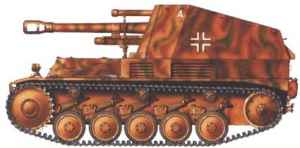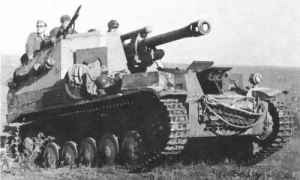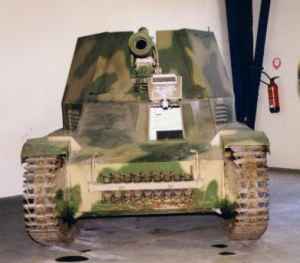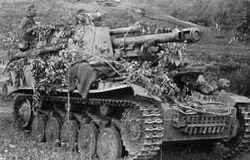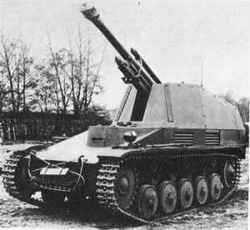| |
In the early 1942, Panzerkampfwagen II (Sd.Kfz.121) light tank was withdrawn from frontline Panzer units and relocated to second line duties after being in service since 1936. That step provided the opportunity to use its reliable chassis and components for conversions such as Marder II tank destroyer and Wespe. Alkett designed Wespe in mid 1942, and its practical design was chosen over other designs based on Panzerkampfwagen III or Panzerkampfwagen IV's chassis. Wespe (Wasp) was a light self-propelled gun armed with 105mm light field howitzer and based on unmodified and modified Panzerkampfwagen II Ausf F chassis. Wespe received designation Sd.Kfz.124 but was also known as 10.5cm le FH18/2 Fahrgestell auf Gesch”Őtzwagen PzKpfw II and as Leichte Feldhaubitze 18/2 auf Fahrgestell PzKpfw II (Sf).
The main idea behind the design of Wespe was to provide all mobile formations with proper and indirect artillery support. Wespe were to operate behind the frontlines and were not to engage enemy vehicles, however they carried armour-piercing ammunition in case of an encounter. Like artillery, Wespe operated in batteries and received orders and directions from forward observers by radio or field telephone reducing the risk of being exposed to direct enemy fire.
Wespe was based on regular Panzerkampfwagen II Ausf F light tank chassis and on modified Panzerkampfwagen II Ausf F chassis. Both versions used many standard components of Panzerkampfwagen II Ausf F light tank. Ausf F was the last variant of Panzerkampfwagen II to enter full-scale production. Ausf F was produced by FAMO of Breslau (Wroclaw) and some 1400 chassis were manufactured, while 524 were completed as tanks from 1941 to 1943. This model featured increased armour protection and other modifications based on the battle experience.
Early version of Wespe was based on regular tank chassis with engine moved forward (to more central location) and suspension was reinforced in order to absorb the stress from firing recoil. Late version was based on modified chassis with slightly lengthened (by 220mm) hull, engine and radiators moved forward (to more central location) and suspension was reinforced in order to absorb the stress from firing recoil. Longer hull result in the increase in the space between last road-wheel and idler. Modified chassis was known as Geschutzwagen II - Gun Vehicle / Gun Carriage II. The configuration of driver compartment was changed during production, creating two variants as well.
Both versions had the same suspension and mechanical components. Suspension was composed of five road-wheels and three return rollers. Wespe had 300mm wide tracks with 108 links per side. Vehicle was powered by 140hp 6-cylinder inline Maybach HL62TR engine with ZFA SSG 46 Aphon gearbox (6 forward and 1 reverse). Vehicle carried 170 litres of fuel in two tanks, which gave it maximum range of 220km. The weight of the vehicle was 11 tons and it could travel at maximum speed of 40km/h.
Wespe was armed with 105mm light field howitzer, which was the mainstay of all artillery regiments during the war. The gun was introduced into service during World War I and in a modified version remained in production to the end of World War II. Wespe was armed with the most common variant of the howitzer introduced in 1935 - 105mm leFH 18. Light field howitzer was produced by Rheinmetall-Borsig. It was mounted in the center of an open-topped armoured superstructure over the engine and behind a gun shield. The tall superstructure was made up of 10mm plates, which provided limited protection for the crew and storage for 32 rounds of ammunition. Inside the superstructure - fighting compartment located was also radio equipment - FuG Spr f - USW transmitter and receiver. Space inside the superstructure was cramped and there was not much space left to operate the gun. The gun itself could be traversed 17 degrees to the left and right and elevated -5 degrees to +42 degrees. 105mm leFH 18 was able to fire high explosive, shaped charge and armour piercing ammunition and had an effective range of 8400 meters (maximum range was over 10000 meters) using Rblf 36 gun sight. Machine gun (7.92mm MG34) and submachine gun (9mm MP38 or MP40) were issued to crews and carried inside the fighting compartment for local defence.
Five men crew composed of driver, commander and three gunners operated Wespe. Gunners were also trained to act as a driver and radiomen if needed. Driver sat in his own compartment in front of the vehicle, on the left side of the gun. His compartment was fully enclosed and had separate access than the rest of the crew. Commander and three loaders were located in the fighting compartment.
In order to supply Wespe batteries with ammunition in the field, an unarmed ammunition carrier designated Munitions Sf auf Fgst PzKpfw II was produced. The vehicle was a regular Wespe without the main armament and opening for it covered a piece of armour plate. It carried 90 rounds of ammunition and was operated by the crew of three. Only 159 of those were produced and were still capable of mounting the howitzer if needed.
Wespe was designed by Alkett (Berlin) and was produced by Famo (Fahrzeug-und-Motorenbau GmbH) in Breslau (Wroclaw) and Vereinigte Maschinenwerke / Famo Warschau (former PZInz) in Warsaw. Originally, 1000 vehicles were ordered but in late 1943, order was reduced to 835, including ammunition carriers. From February of 1943 to July/August of 1944, 676 Wespe along with 159 ammunition carriers were produced (chassis number 31001 to 32190).
Wespe was issued to Panzer division's artillery batteries - Panzerartillerie starting in spring of 1943. Each battery had six Wespe and two Wespe ammo carriers. Wespe's first major action was at Kursk in July of 1943, where it proved to be very effective and afterwards saw active service on all fronts until the end of the war. There were some 307 in service as of March of 1945.
Wespe saw service with following Wehrmacht and Waffen SS units on all fronts from 1943 to 1945; Panzer Divisions: 1st, 2nd, 3rd, 4th, 5th, 6th, 7th, 8th, 9th, 11th, 12th, 13th, 14th, 16th, 17th, 19th, 20th, 23rd, 24th, 25th, 26th, 116th, "Feldherrnhalle", "Tatra", "Grossdeutschland", 1st SS "Leibstandarte SS Adolf Hitler", 2nd SS Das Reich, 3rd SS "Totenkopf", 5th SS "Wiking", 9th SS "Hohenstaufen", 10th SS "Fruendsberg" and 12th SS "Hitlerjugend"; Other: 7th Freiwilligen Gebirgs Division "Prinz Eugen", Fallschirmjaeger-Panzer Division "Herman Goering", Panzer Grenadier Division "Brandenburg", Fuehrer Grenadier Division and Panzer Brigade "West". 1st SS Panzer Division "Leibstandarte SS Adolf Hitler" was the first Waffen SS unit to receive Wespe.
Today, Wespe can be seen in the Musee Blindes in Saumur, France; the Memorial Museum in Bayeux, France; BWB Wehrtechnische Studiensammiung in Koblenz, Germany; and at NIIBT Kubinka, Russia.
|
|
|



